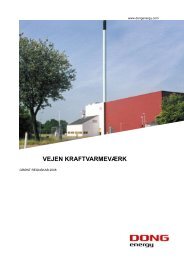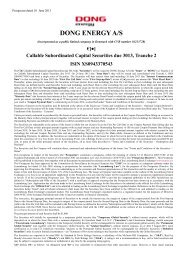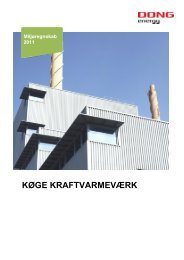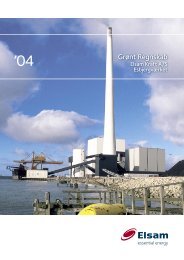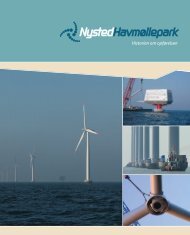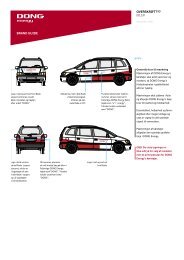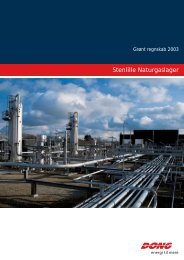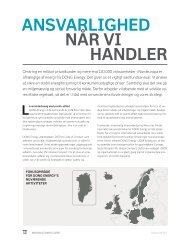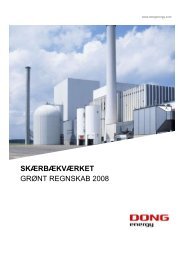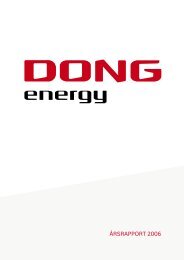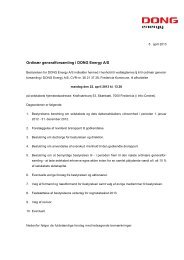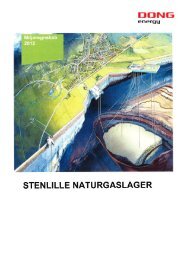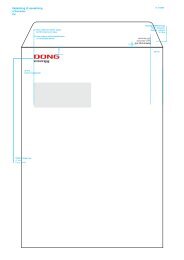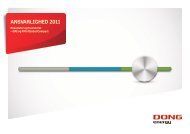ANNUAL REPORT 2011 - DONG Energy
ANNUAL REPORT 2011 - DONG Energy
ANNUAL REPORT 2011 - DONG Energy
Create successful ePaper yourself
Turn your PDF publications into a flip-book with our unique Google optimized e-Paper software.
The excess of the cost of the acquiree over the fair value of the<br />
assets, liabilities and contingent liabilities acquired is recognised<br />
as goodwill and allocated to the cash-generating units,<br />
which subsequently form the basis for impairment testing. In<br />
that connection, management makes estimates of acquired<br />
and existing cash-generating units and the associated allocation<br />
of goodwill.<br />
Judgements in connection<br />
with accounting policies<br />
As part of the Group’s accounting policies, management<br />
makes judgements, apart from those involving estimations,<br />
that may have a signifi cant effect on the consolidated fi nancial<br />
statements. These judgements primarily comprise a) choice<br />
of recognition methods for exploration assets, b) recognition<br />
and classifi cation of derivative fi nancial instruments and commodity<br />
contracts, c) classifi cation of hybrid capital, d) jointly<br />
controlled assets and entities, and e) business combinations.<br />
accounting treatment of exploration<br />
When capitalising exploration costs, <strong>DONG</strong> <strong>Energy</strong> applies<br />
the successful efforts method rather than the full cost method.<br />
Accordingly, general exploration costs and costs for unsuccessful<br />
exploration wells are expensed as incurred. <strong>DONG</strong><br />
<strong>Energy</strong> will therefore have a lower value of exploration assets<br />
than companies that apply the full cost method. At 31<br />
December <strong>2011</strong>, exploration assets amounted to DKK 1.6 billion<br />
(2010: DKK 1.0 billion). Depreciation of production assets<br />
that have been transferred from exploration assets will also be<br />
lower when applying the successful efforts method than when<br />
applying the full cost method.<br />
accounting treatment of derivative fi nancial<br />
instruments and commodity contracts<br />
<strong>DONG</strong> <strong>Energy</strong> hedges commodity, currency and interest rate<br />
risks. These hedging transactions predominantly relate to future<br />
income from the sale of oil, gas and electricity, and costs<br />
for the purchase of coal, gas and CO2. From and including 1<br />
January <strong>2011</strong>, new and existing commodity hedge transactions<br />
and related foreign currency exposures are no longer accounted<br />
for as cash fl ow hedge accounting.<br />
As part of its fi nancial risk management, the Group enters into<br />
transactions to hedge certain physical and fi nancial risks in oil,<br />
gas, coal, electricity, CO2 and related currency exposures. The<br />
Group considers the hedging transactions entered into on the<br />
basis of its internal processes for optimisation of its purchase,<br />
sale and consumption of oil, gas, coal, electricity and CO2 , as<br />
effective economic hedges. Some of the hedging transactions<br />
will meet IAS 39’s criteria for cash fl ow hedge accounting,<br />
while others will not. For this reason, the Group has elected to<br />
no longer apply the provisions on hedge accounting to these<br />
transactions from 1 January <strong>2011</strong>. When determining profi t for<br />
the year, fair value adjustments to these derivative fi nancial<br />
instruments are therefore recognised in the period in which<br />
they arise, regardless of the date of realisation of the hedged<br />
transaction. Value adjustments from fi nancial contracts therefore<br />
have a greater impact on the income statement for <strong>2011</strong><br />
than in previous years.<br />
Contracts to which the Group is a party are reviewed to assess<br />
whether they contain any components that are required to be<br />
recognised and measured as separate fi nancial instruments.<br />
The Group enters into contracts that include price formulas<br />
that are indexed to various energy prices, commodity indices,<br />
etc. Based on a review of these contracts, it has been judged<br />
that the individual components of the contracts feature identical<br />
characteristics and therefore do not differ signifi cantly.<br />
Separation of the individual components of the contracts is<br />
therefore not required, except in the case of the assessment of<br />
hybrid capital.<br />
Under IFRS, contracts that involve physical delivery must,<br />
under certain circumstances, be accounted for as derivative<br />
fi nancial instruments. The classifi cation is determined based<br />
on an evaluation of the purpose of the contract compared<br />
with the Group’s other activities. It is generally assumed that<br />
those of the Group’s contracts that are settled on physical delivery<br />
do not satisfy the criteria for classifi cation as derivative<br />
fi nancial instruments, as they are normal purchase and sale<br />
contracts. By contrast, contracts entered into in the course of<br />
the Group’s trading activities or as part of certain hedging activities<br />
are recognised as derivative fi nancial instruments, even<br />
though they are settled on physical delivery.<br />
accounting treatment of hybrid capital<br />
Hybrid capital, DKK 9.5 billion (2010: DKK 8.1 billion), comprises<br />
issued bonds that have been recognised in a special item<br />
in equity due to the special characteristics of the loan and the<br />
provisions on compound fi nancial instruments. Accordingly,<br />
any coupon payments are accounted for as dividends that<br />
are recognised directly in equity at the time the payment<br />
obligation arises. This is because the coupon payments are<br />
discretionary and relate to the part of the hybrid capital that<br />
is recognised in equity. Coupon payments consequently do<br />
not have any effect on profi t for the year and are recognised in<br />
fi nancing activities in the statement of cash fl ows in the same<br />
way as dividend payments.<br />
Jointly controlled assets and entities<br />
<strong>DONG</strong> <strong>Energy</strong> has opted to recognise the Group’s jointly<br />
controlled assets and entities using proportionate consolidation.<br />
These primarily comprise oil and gas exploration and<br />
production licences, and wind farms and power stations. New<br />
<strong>DONG</strong> ENERGY <strong>DONG</strong> ENERGY GROUP <strong>ANNUAL</strong> <strong>REPORT</strong> <strong>2011</strong> – COnsOliDatED finanCial statEmEnts<br />
75 71<br />
notes



